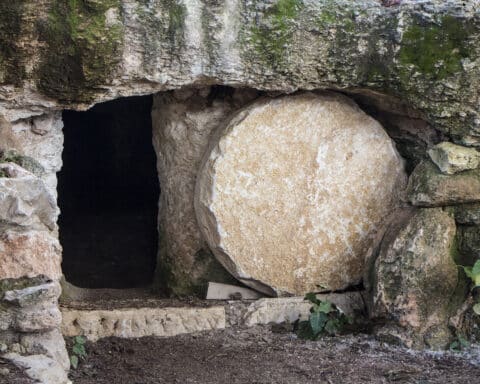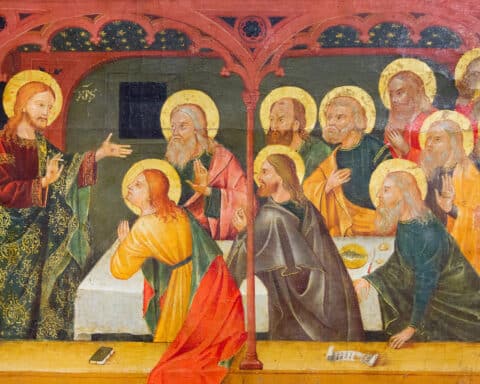Every aspect of human life is embodied. We see, hear, touch, taste and smell our way through the world. Even things we tend to think of as purely intellectual or spiritual activities — thinking, feeling, worshiping — are rooted in our bodies. The mind cannot think without making use of a brain. And if you believe that prayer is not a bodily activity, try praying without your body some time and see how far you get. Easter forces us to think about our bodies. Jesus saves us in and through his body. In his resurrection, he gives us a glimpse of what our bodies will ultimately be like. Therefore, the more we understand about the body of Jesus, the better we will understand our own embodied existence.
In his Theology of the Body, Pope St. John Paul II teaches that our bodies are not things we possess but who we are. “Man belongs to the visible world,” he said. “He is a body among bodies.” This realization frees us from two common philosophical errors of our age. The first is a new form of an ancient heresy called gnosticism, a belief that what matters most in life is our internal knowledge of ourselves. Our bodies do not matter. If we want to be happy, we need to discover our inner truth. We can then mold our bodies accordingly.
Christians are not immune to this way of thinking. Many Christians — including many Catholics — operate under the misconception that only our souls matter. But if we are our bodies, then we cannot act as if our bodies are incidental to whom we are. The union of body and soul is not like that of a video game player to an avatar on a screen. Our bodies and souls are meant to be fully integrated. We might describe them separately, but outside of death, we do not experience them separately. Your body is the real you.
Theology of the body also frees us from the opposite error of materialism. While gnosticism says the body is incidental, materialism says the body is all there is. Human beings are merely complex collections of molecules. We are walking chemistry experiments, nothing more. What we think of as our minds, our rationality, even our feelings — all of these are just conditioned responses to stimuli. There is no soul.
This way of thinking assumes that the spiritual and the physical must be in competition, but that is not the case. “The body, in fact, and only the body, is capable of making visible what is invisible: the spiritual and the divine,” John Paul said. The way we know that we have a soul is through our bodies. Our reasoning, our faith and especially our compassion are all signs of something more than the body alone is capable of, yet we only experience these things through our bodies. Our bodies show us that we are more than just mere matter. We were created to be something far greater.
The resurrected body of Jesus helps us to see this truth more clearly. John Paul II uses as a starting point the conversion of St. Paul, which was made possible because Paul “had experienced in his meeting with the risen Christ the state of his glorified body.” This experience informs the way Paul talks about the future destiny of our own bodies in Romans 8 and 1 Corinthians 15.
One of the reasons that it is easy for us to fall into the errors of gnosticism and materialism is that our experience of having bodies is not always that great. We have aches and pains. We get sick. We suffer from physical limitations. Eventually, we die. Paul acknowledges this, but he said that although our bodies now are weak and perishable because of sin, they have the potential within them to be so much more. As John Paul II explains:
“When Paul writes: ‘The first man was from the earth, a man of dust; the second man is from heaven’ (1 Cor 15:47), he has in mind both Adam-man and also Christ as man. Between these two poles — between the first and the second Adam — the process takes place that he expresses in the following words: ‘As we have borne the image of the man of earth, so we will bear the image of the man of heaven’ (1 Cor 15:49). … This ‘man of heaven’ — the man of the resurrection whose prototype is the risen Christ — is not so much an antithesis and negation of the ‘man of earth’ (whose prototype is the first Adam), but is above all his completion and confirmation.”

Paul said the resurrected body is a “spiritual body.” This is not because the resurrected body ceases to be physical, but because it gains the fullest possible integration of the physical with the spiritual. John Paul says that “the spiritual body should mean precisely the perfect sensitivity of the senses, their perfect harmonization with the activity of the human spirit in truth and liberty.” Right now, because of the fallenness of the world we live in, our bodies cannot transcend certain limitations, but that will not always be so. In his resurrection, Jesus experienced a complete integration of body and spirit, with nothing else standing in the way, and that transformed his body into a fuller, more realized version of what it was always meant to be. In our resurrection on the last day, we will go through the same kind of transformation, provided we remain in Christ.
We were made to live forever. Not just our souls, but our bodies, as well. Even now, our bodies point to that greater reality that will be fulfilled in the resurrection. Every single expression of love is a sign of our potential for resurrected glory. Expressions of love are also bodily, even though they arise from the gift of God in our souls. An offering of a corporal work of mercy, an embrace or sign of affection, even the swelling of emotion in the heart, all of these are conducted in and through our bodies. Each is a sign of the fact that we are made in the image and likeness of God.
“Every man bears in himself the image of Adam,” John Paul said, “and every man is also called to bear in himself the image of Christ, the image of the risen one.” Our bodies are burdened by the effects of original sin, but our bodies are also signs of hope that in the resurrection our capacity for love will become limitless. As we look this Easter at the bodily transformation that Our Lord underwent, we should see there a vision of our own future. The goodness of the resurrected body of Jesus confirms for us the goodness of our own bodies, even in their current state of imperfection. Our bodies make it possible for us to know, experience and share the love of God in the world.
Father Jonathan Mitchican is a Catholic priest and school chaplain. Follow him on Twitter @frjonathan.





